If you were to draw all of Jim Schroer’s travels on an atlas of the world, it would look as if an untended toddler had scribbled all over it with great scrawls across two oceans and a tangle of squiggles all over the eastern half of the U.S. But the intricate lines are the tracings of a waterman’s life, shaped by water winding across a continent and wind wandering over oceans.
Jim had never intended to share his stories beyond his family and friends. The notion of publishing anything soured after his first ocean crossing: “After my girlfriend and I sailed a 19 1⁄2′ boat to Hawaii, she talked to a person who was writing an article while I was out trying to earn some money so we could fly back to the mainland. It must’ve been a year later when we were cruising in the Florida Keys and crossed paths with somebody who had read the article. He showed us the magazine it was in and asked, ‘Is this you?’ We said it was. The title of the article was ‘From Yachts to Buckets They Come to Hawaii.’ Of course, the bucket was our boat, which I did not appreciate much. So, I figured people who write articles are more concerned with themselves than the people they’re writing about. And I don’t think that about you, and it’s because I’m comfortable with what you do that I’m doing this. This is very different for me because I’ve never gone for recognition or fame or whatever you might call it. But I’ve been reading your articles and what you’ve done and that convinced me that I could do this.”
Jim passed away suddenly and unexpectedly in December of 2022. His wife Sher and his daughter Zoey were eager to have me publish his story in Small Boats and provided invaluable assistance with finishing this project. In 2022, I recorded two long phone conversations I had with Jim. The last call ended with him laughing and saying, “Okay, this might be the longest I’ve ever been on the phone.” Below, in his words, is what he had to say.
Travels and Boats
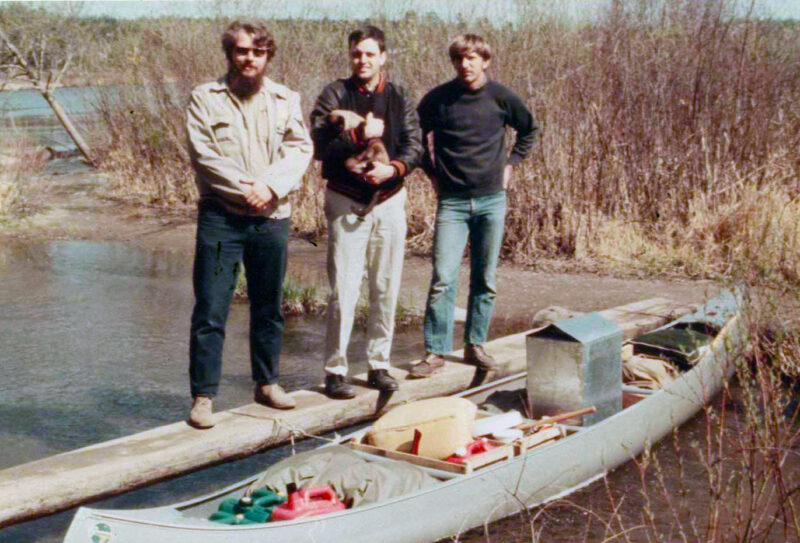 Photographs courtesy of the Schroer family
Photographs courtesy of the Schroer familyJim (right) had two friends, Cal Hand and Bill Hinkley, see him off as he launched his Grumman canoe to paddle the Mississippi River from its headwaters to the Gulf. Cal and Bill were musicians and future members of the band, The Sorry Muthas, and went on to perform on A Prairie Home Companion.
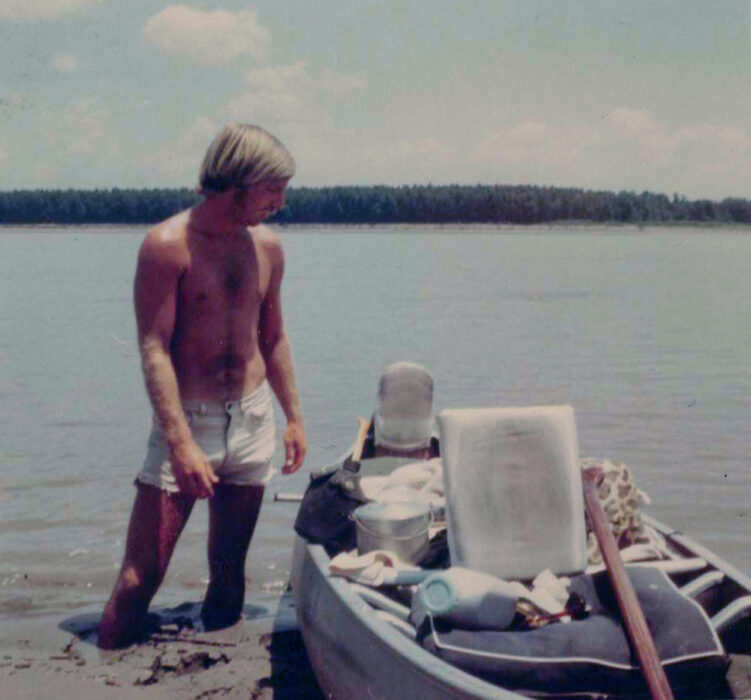
Jim encountered muddy shores on the Mississippi River.
The first thing was the Mississippi River in 1968 and that was about three months in a 17′ Grumman from Itasca to New Orleans. I did Itasca to Minnesota alone and then I picked up a girlfriend and did the rest of it with her.
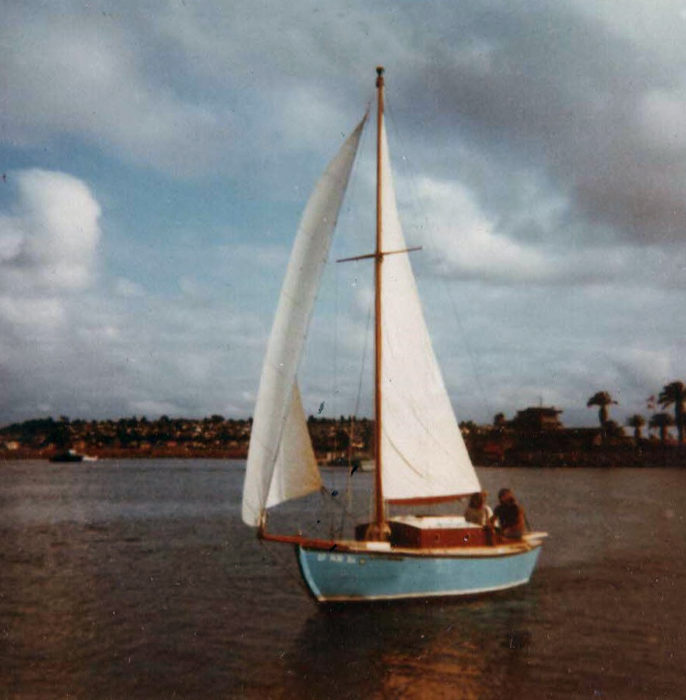
Jim: “My girlfriend, my cat, and I crossed the Pacific from California to Hawaii in this 19 1⁄2′ sloop.”
After the Mississippi, my girlfriend, cat, and I hitchhiked back to St. Louis to get my truck. We then went west to California and bought a little blue-hulled 19 1⁄2′ sloop. Apparently, the owners thought they had broken something underneath. When we hauled it out, the plywood form that they had poured the cement keel into was torn off, half torn off, and sticking out. I guess they thought it was the keel itself. We got the boat cheap and just ripped the plywood off. We used a bunch of instant concrete and smoothed it up.
We didn’t know anything, but I read everything in the San Diego library about singlehanded sailing. I then had a lot of theoretical knowledge but no experience. We sailed the sloop to Hawaii. I had rerigged it with two jennies to run downwind, a tradewinds thing, but they overpowered the little boat, so we only used one. That was better than the mainsail, which made it difficult to steer—it wanted to round up when we didn’t want to round up. Our slow trip to Hawaii took 39 days. In Hawaii we sold the boat. That was in 1969.
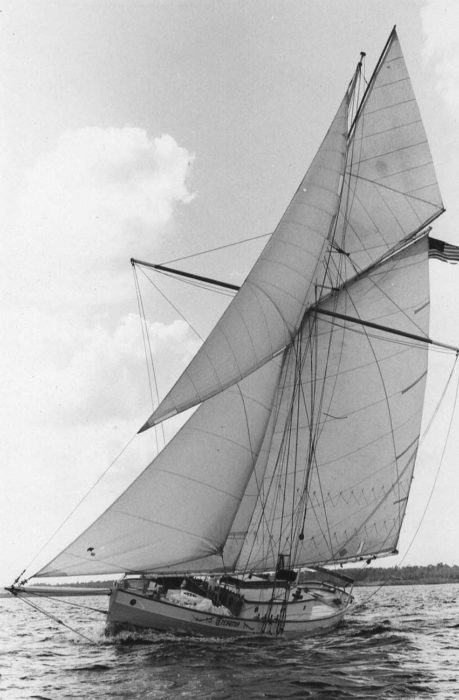
Jim: “I lived aboard this 1959 cutter, TRESARUS, for 13 years, had it for 15 years, most of the time without a motor. I sold the motor to keep sailing. I sailed around the islands in the Atlantic and back to the Caribbean and up and down the coast a couple of times. It’s a William Atkin fore-and-aft cutter, very English. Strip-planked and quite a nice boat, it was 15 years of my life.”
After that, the big one was to the Atlantic islands in 1975 in the TRESARUS, a 28′ 8″ Atkin cutter. I left Cape May, New Jersey, and sailed to the Azores, Madeira, Cape Verde. That was with a girlfriend, a different one, but they were close friends. [Laughs] When one departed, the other one moved right in. I sailed alone after Cape Verde and had the fastest passage over to Barbados. That was just under 15 days. That was not fun, but I always said if I had the chance to do something fast in the boat, I would just grit my teeth and do it just so I could brag about it. It was horrendous. It was noisy plowing through the water all the time, bashing around, and having a hard time staying in the bunk. There were times the boat slowed down to 4 knots and I’d put up the topsail and get it back up to 5 1⁄2. I had back-to-back 265-mile days in that little cutter. Normal sailing would be 100 miles per 24 hours. From Barbados, I went up the island chain to the U.S. Virgins and then I sailed to Panama to go through the canal, but I didn’t get to, so I sailed up to Newport. That was in ’75. I don’t recall how long that took.
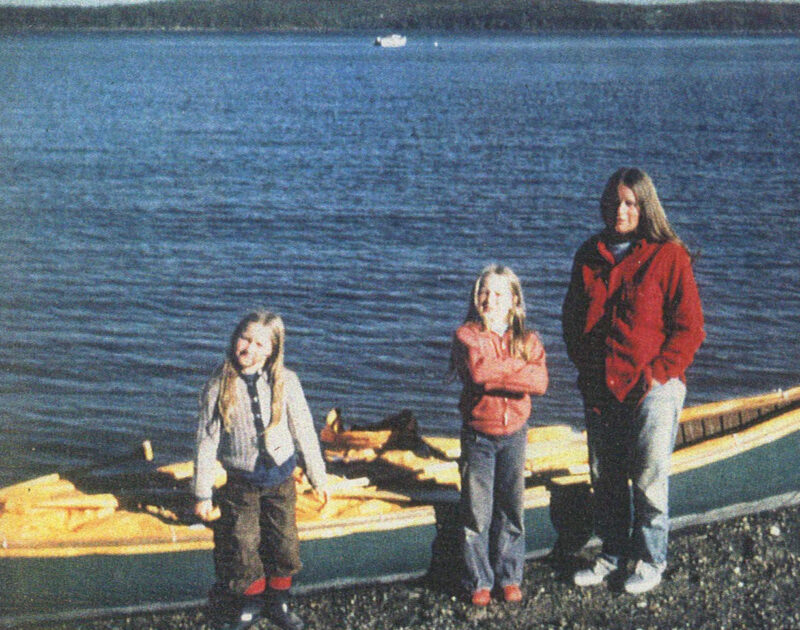
Robin, Zoey, and Sher paused at the Penobscot Bay launch site just before embarking on a four-month cruise.
My wife Sher, daughters Robin and Zoey, and I did a long canoe trip ’79. That was what I call the Maine Triangle. It’s probably the trip I’m most proud of. That was with a boat we called TSHANNA, which is an Indian name for The Silent One. It was a wooden and canvas 20 footer and it was quiet. We had rebuilt that. We re-canvassed it and patched up all the broken frames. It was a $30 canoe when we bought it—well, my wife, Sher, and the girlfriend bought it—for my birthday and we took it to Florida. We were then living on that cutter. We did that in a little park next to the marina. We re-canvassed it, and got it ready and then we hauled it all the way up Maine. My wife and I and two daughters—I don’t really remember if the cats went or not—went up the Penobscot, and up the West Branch and up the North Branch until we ran out of water. It was a beautiful month, and it didn’t rain on us hardly at all, so we didn’t have any water when we got to the North Branch. So we backed down and went over, what’s that called, the Mud Pond Carry. And then we got into the Allagash, and went down the Allagash to the St. John, and down the St. John to the coast and down the coast to Penobscot Bay and up to where we started the trip and left our vehicle. That was about two-and-a-half, almost three months. Great trip, a great trip. The girls don’t want anything to do with boating anymore. I lost my crew after that trip.
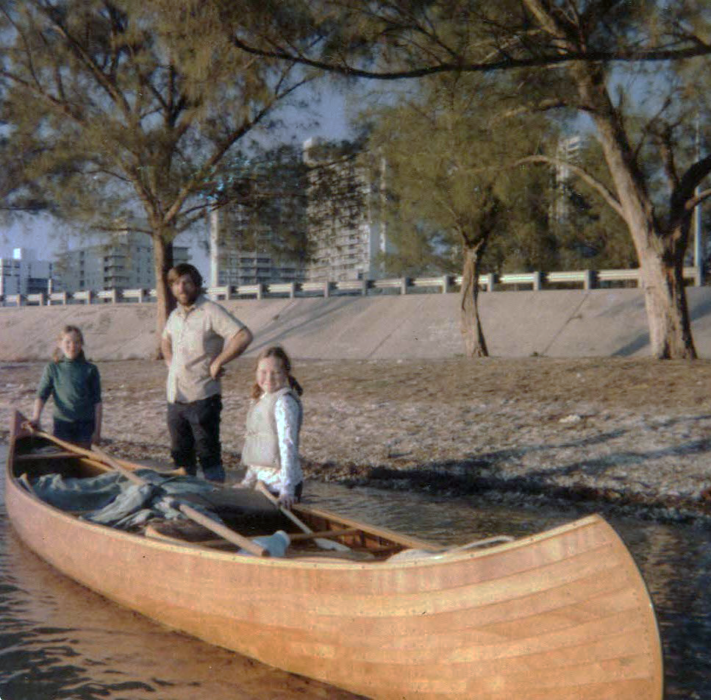
Jim, with daughters Robin and Zoey, about to embark on a cruise to the Florida Keys on TEATIME TURTLE, the lapstrake canoe he built.
Did I tell you about the problems in the Florida Keys, getting raided because we were camping hidden in the woods? Well, let me see, that was TEATIME TURTLE, the 22′ lapstrake. It was 1981 and we got a delivery car to drive to Miami, Florida, and we put this great big canoe on top of it, which you’re not supposed to do on a delivery car. This was with the two girls, twin daughters Zoey and Robin, who were 9 at the time. We never got to pick the car and just got what they had available, but I couldn’t complain about the Mercedes. It was very nice. I dropped the canoe and the family on the beach in Miami and delivered the car and got back somehow. Off we went in the canoe. There were lots of little islands, so we didn’t have to go very far to make our first camp. I remember the island was full of flip-flops. We had a contest to see who could get a pair of flip-flops that fit. That was great fun. We paddled along the Florida Keys and got down to Marathon. There we went into the harbor, way up into the top of it, found some woods, and hauled out. We put up a tent and made a barricade to hide the canoe and covered it with a tarp. We were there for days while I went to work at a marina. It was almost Christmas. We didn’t have any money, so I had to make some. I varnished a boat and did this and that. One day I came back and Sher was real upset because the police had shown up and told her it was illegal to camp there. They took her and the girls down to the station, hassled them, and then told them that if we continued camping, they would confiscate the girls. While they said they would take the girls away, they couldn’t actually do much to us because we were from out of town and not Florida residents. They couldn’t get us for the girls not being in school.
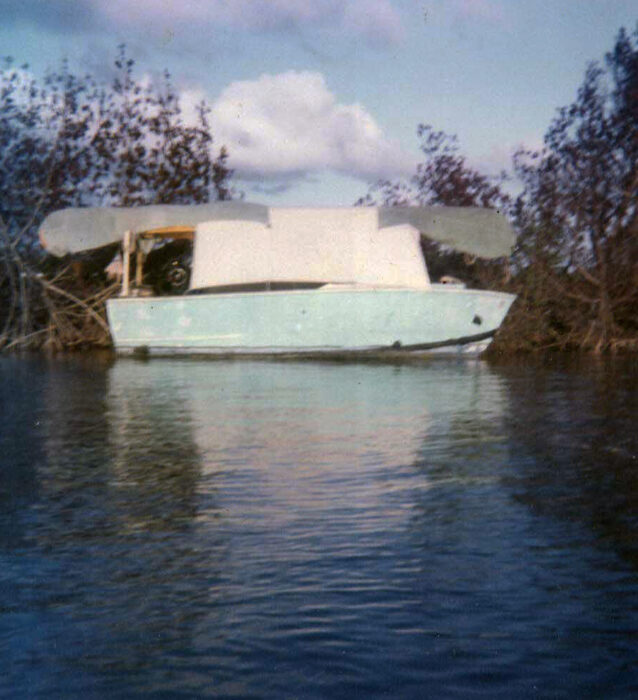
TEATIME TURTLE formed part of the roof over the derelict motorboat that was home to the family.
Sher didn’t want to continue after that. We paddled out and stopped to talk to a guy on a boat. He had two more boats in the harbor, and he let us spend the night on one of them. But then his wife didn’t like the idea of him letting weirdos stay on the boat, so we went over to where the fishing fleet was. They were cleaning out the area with a bulldozer making a pile of junk, a great big hill of junk. On top of it was this old plywood motorboat, an open boat, and kind of big but with a hole in it. I found a guy with a pickup truck and told him I’d give him a couple of six packs if he would pull the boat down and to the water. He did, happily, and I patched the hole and we put it into a little creek area of the harbor. We moved aboard it, and the police never bothered us again. We put the canoe on top and then the tarp over it and we had it enclosed that way. We spent the rest of the winter in that junk boat meeting all sorts of interesting people including Cubans who were arriving about that time. They loved the girls and would bring them food. They thought we were destitute, I guess, but we weren’t really.
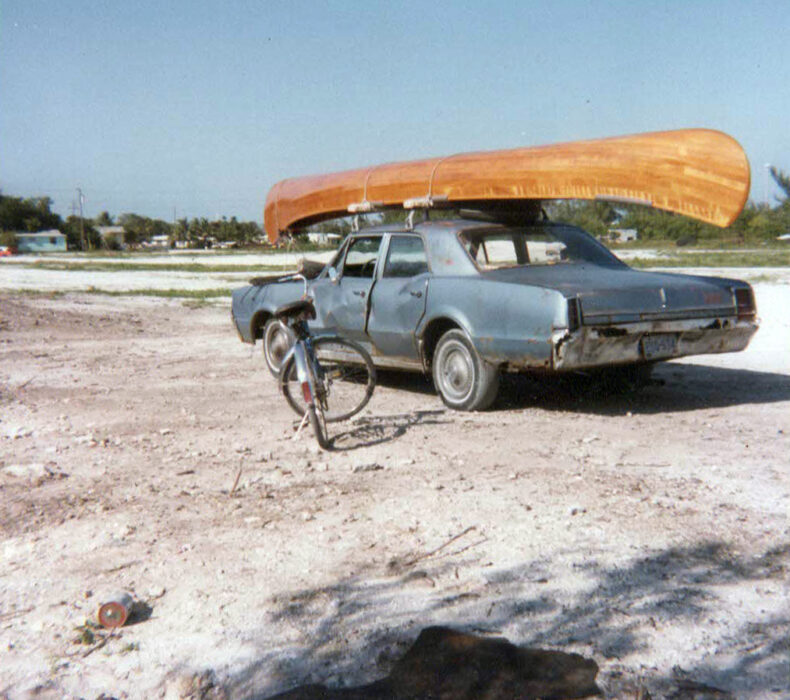
The back of the Oldsmobile was riddled with rust but stayed in one piece on the road.
I bought an Oldsmobile from a fisherman and I guess he used to throw fish in the trunk because it was really rusted out. To get it ready to haul us back to Rhode Island I took it to a mechanic and said, “I’d like it looked at to see if it would get us back to Rhode Island. Could you put it on the lift?” He took a quick look under it and said, “No, we can’t lift it because it’ll probably break in half.” We decided to forgo that and drove it to Rhode Island anyway. It was a great comfortable car, but I couldn’t get out of the driver’s door because it was smashed. I had to get out the passenger door, but otherwise it did really well. It was just difficult to pay tolls.
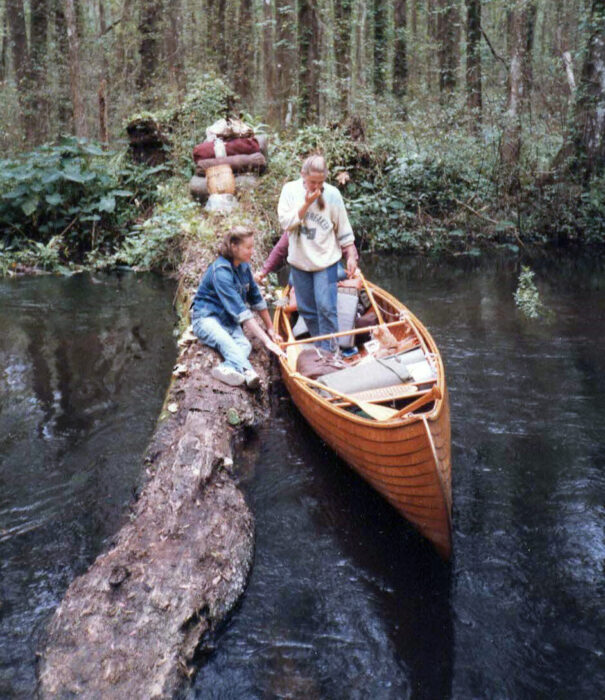
Robin and Zoey were older when the family cruised northern Florida.
Our north Florida trip was in ’87 with TEATIME TURTLE, the varnished 22′ lapstrake canoe. I had a boat shop in St. Petersburg, Bayside Boatworks, for a couple of years. The Atkin cutter was in a little bitty harbor behind the Salvador Dalí Museum and the shop was about a block away from the water, so we could go down to look at the boat. We were living in a school bus at the time.
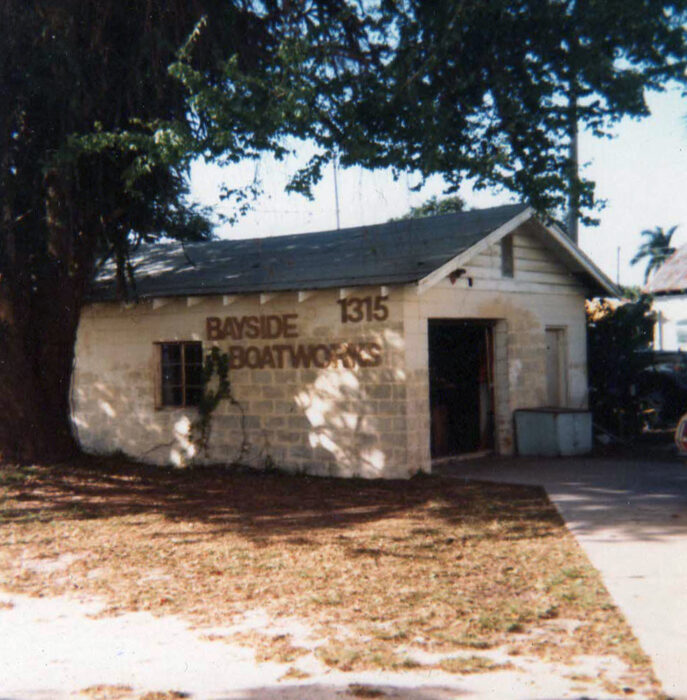
While in St. Pete, Jim opened a business doing boat repair.
Anyway, that canoe trip was up the St. Marys River, down the Suwanee, and then along the Gulf coast, up the Withlacoochee, down the Hillsborough, and into Tampa.
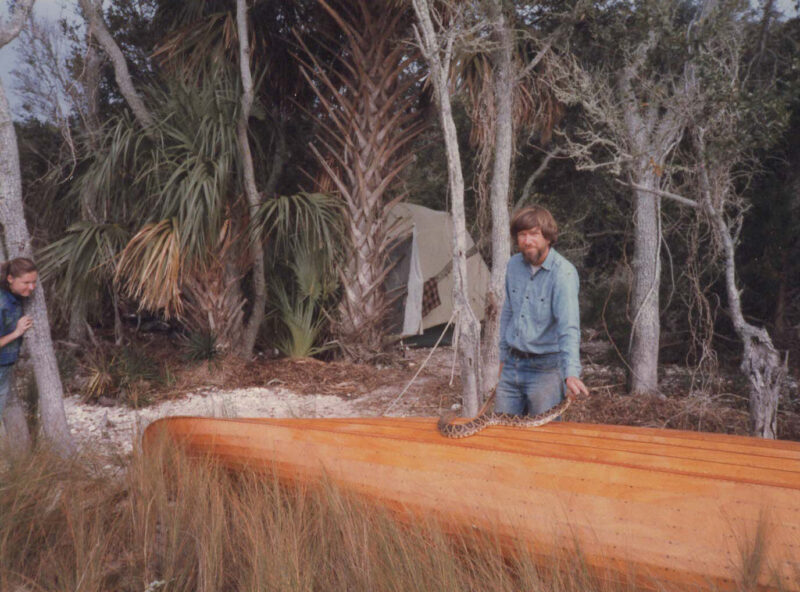
At Rattlesnake Key in Tampa Bay, Jim came across a rattlesnake while he was walking on the island where the family had camped. He cut off a branch with a fork in it, took photos, gave a dissection lesson to Zoey and Robin (who’s peering in from the left), and served it for dinner. Zoey recalls, “It tasted like chicken.”
The friends who took us to the St. Marys lived in Tampa, so we called them up and went back home with them to where the truck was. You know, I haven’t found any sort of notes or log on that trip so I really don’t know how long that was. It was a winter trip and cold a couple of times because we had frost on the canoe. It looked like snow.
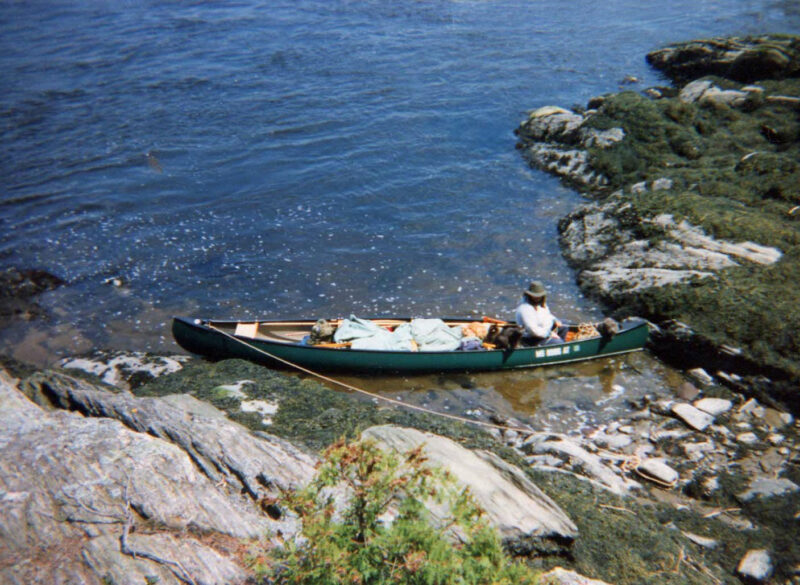
While Jim stepped ashore, Sher and the four conscripted feline sailors—Looper, Friends, Rebar and Beanie—remained on board the 20′ Old Town canoe.
And then, let’s see, the nine-month canoe trip in Maine was in ’95–’96. It was an open-ended trip without a destination. The girls were much older so Sher and I went without them but with our four cats. We were going to paddle forever—that’s what we had in mind. We started at Popham Beach, just below Bath, and went up the Kennebec River and all the way up the Androscoggin to Errol, New Hampshire. There we portaged by vehicle—that’s where you go talk somebody into taking you over in a pickup truck or stick your thumb out—over to the Connecticut River. It’s not very far actually, just one highway, and that was to Colebrook. Then we paddled down the Connecticut River, through Massachusetts and Connecticut all the way down to the coast. A great trip. A great river.
There we got picked up by friends from Rhode Island and taken back home so Sher could visit with our daughters. It was September and I knew that we were going to get caught by weather, so I bought a junker and we loaded up and, instead of taking the canoe west to the Genesee River, which dumps into Lake Ontario, we drove to Pennsylvania and started on the upper Allegheny River.
And, of course, the police caught us there. Well, I wanted to sell the car and the guy I tried to sell it to called the police and said, “This guy is trying to sell me a stolen car.” They didn’t catch us driving but as we were unloading the canoe from the roof racks and getting ready to go down the river. Somehow, they just decided to forget it. Maybe because we weren’t driving. Anyway, they did all the stuff they had to and left. I gave the car to somebody.
Sher and I paddled down the Allegheny to the Ohio River then up the Kanawha. At the New River, Sher’s sister from Boone, North Carolina, came up with a little Coleman canoe, and Sher went to North Carolina with her in the big canoe. I went up to the New River, which was a fantastic, very interesting trip. When I got into North Carolina it was freezing. My tennis shoes would be frozen outside the tent every morning.
Once I got to North Carolina, I thought that’s good enough. Sher and her sister picked me up and we did Thanksgiving in Boone. We bought a motor for the canoe because I thought we could still maybe beat winter if we had a motor. That was stupid, because we didn’t beat it, and Sher’s sister and husband gave us a portage over the height of land over to the French Broad River. We descended the Tennessee River, and then the Tombigbee River down to the Gulf coast. We did a little along the coast, but I knew that if we went too far we’d wind up back at Cedar Key where we had already been on our North Florida trip. It was too early to head back north and I couldn’t think of anything else so we kind of gave up. A friend flew down, rented a truck to carry the canoe, pick us up, and take us to Saint Pete. We stayed there a while. But anyway, that was that trip, a big one.
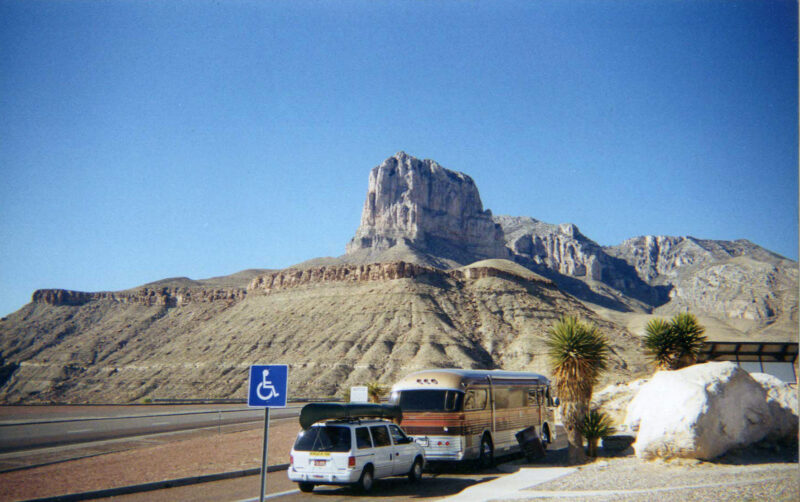
Sher and Jim toured the country in a motor coach with a van and canoe in tow.
We bought a van that my brother had for sale cheap, mainly because it needed a lot of work. I fixed it up and we made a bed in it. We traveled in it for a year and then found a nice motorcoach in Florida. We traveled in it and towed the van with the canoe on top of it. That was from ’96 to ’99 and we went paddling here and there.
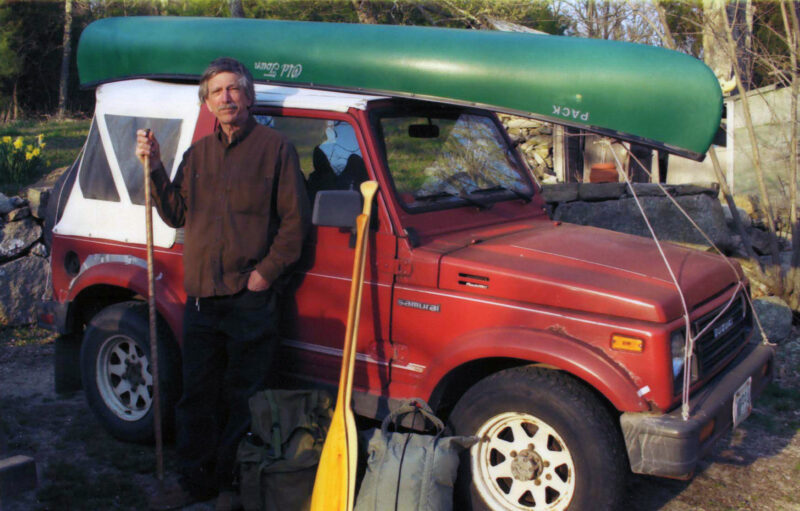
While Jim was working at the camp, he took many week-long solo canoe trips.
In 2000, I got this job as caretaker here at a camp in Rhode Island. Or I should say my wife got me this job. It really wasn’t my idea. So, after 2000 it has just been trips of a week to 10 days on New England rivers doing all of the river except for the whitewater parts at the beginnings. A couple of rivers I split in half and did three days for part of it and three days the rest of it, like the Kennebec. I did the Machias River, the Grand Lake Stream, the Delaware River, and the Saint John River, which is up along Canada. The Saint John was interesting because without a passport I couldn’t camp or even land on Canada’s side. It was the first river that had only one bank that I could get out on.
These trips were all in solo canoes. One was a 14′ Bell Wildfire made of ABS. Then I got a lighter one, which was a Mohawk Solo 13. The Solo 13 is 1′ shorter and not as pretty but it’s lighter and I’m getting older, so that is good. Then I got a a 12′ Kevlar ADK and went for three or four years doing different things in the Adirondacks, mostly for a week at a time.
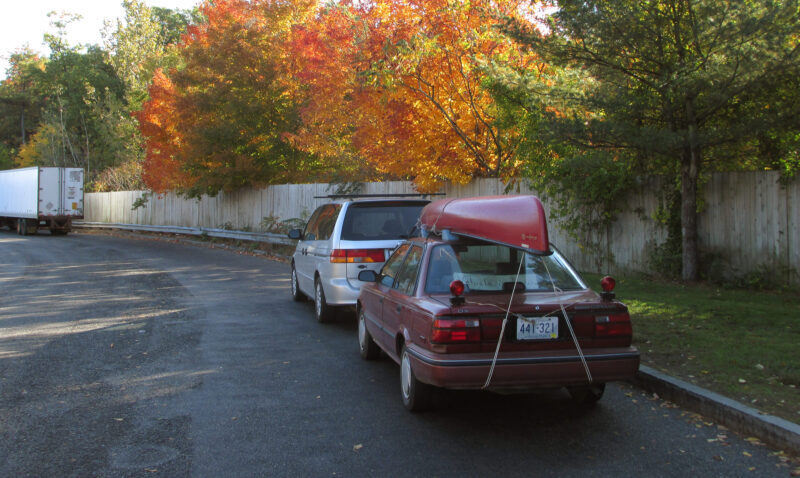
Jim: “I have a shuttle car that I do all my solo trips with. I have a Honda van, an old one, an Odyssey, and I tow a ’91 Corolla with a canoe on top. And then I can drop it off and go up to the headwaters and paddle down to the Corolla. I’ve taken the rear seat out of the Corolla so I can sleep in it and then drive back up to the headwaters and pick up the Odyssey, then tow the Corolla back home. I’ve done that for ages, the past 20 years, and it’s worked out very well.”
In 2020 I drove to the Susquehanna River. It starts in New York and continues all the way down to the Chesapeake. That’s a big river so I did just the part in New York. That was the first year of the pandemic, so nobody was on the banks and nobody was on the river. The highway runs along the river almost the whole way so I hid water bottles on my way to the put-in so I wouldn’t have to go to people’s houses to ask for water. That worked out really well. A good trip.
There was another nice solo in 2014 that took 10 or 11 days from north to south in Rhode Island. I started up near the northern border and worked my way down the river to the bay. I got out of the bay at Fall River and paddled several rivers and came out at Westerly. I crossed over to Connecticut and took out.
I guess that’s about it. It has been pretty constant.
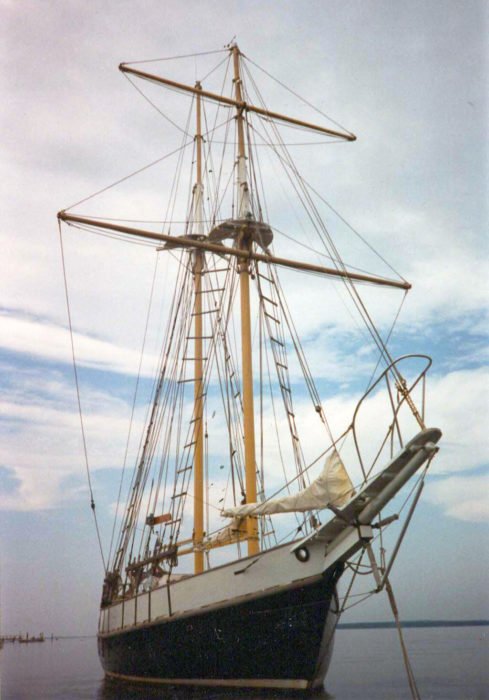
Jim: “My brother asked me: ‘Do you want a schooner,’ and I said, ‘Are you kidding me?’ This is after I had sold the others, my last sailboat. He was working in a boatyard and he knew this boat, DISTANT STAR, had sunk at the dock and the owner was not being responsible. The boatyard wanted it out, so he said to me I’d better come look at it. And I got it for under $2,000. I really really didn’t want the schooner; I was really done with sailboats. I sort of refurbished it. All I did was make it look pretty to resell it.”
There are a few things other than boating. There was flying. I always have my eyes up in the sky when I hear something. I love the biplanes and always wanted to buy a Stearman biplane. I remember when they were about $5,000 and I just didn’t have quite that much. Then I sold the DISTANT STAR, the big schooner, and I said, “Gee $25,000! I can get a Stearman now.” I looked it up and they were $60,000 at that time. So, okay, I’d forget that dream. I did hot air ballooning and got my certification for that and for gas balloons because it was early on and they weren’t too organized and they just put them both together. If you could answer the questions about the dangers of gas, you got the certificate for gas (even though I couldn’t afford to fill a balloon up with it). In the ’90s my wife and daughters bought me hang-gliding lessons, so I did hang gliding for about three years. I got up to Hang 4, which is an advanced rating. With it I could technically fly off any mountain. That was really cool. I loved it.
The other fun thing was motorcycling. I’ve had five motorcycles. The biggest fun trip was with my daughter Zoey, from Saint Pete up the Smokies all the way to Rhode Island. I was really surprised that she agreed to go. And I once did 1,000 miles in 24 hours just for the heck of it.
What in my background led me to do all this? I would say one thing. It was the fact that my dad was a schoolteacher and a principal and I went to his junior high school. He retired a year early and talked about what he and my mom could do, but then he died that year, the year he retired. So that probably influenced me. I know that in college—I went to Southeast Missouri State in Cape Girardeau, Missouri—the Mississippi River ran nearby and I would go down to it quite often. It gave me what I needed for the four years that I was in school. Instead of looking forward to what the school could give me, I think I looked forward to what the rivers could give me.
JAYCEE BODIE, Jim’s last boat
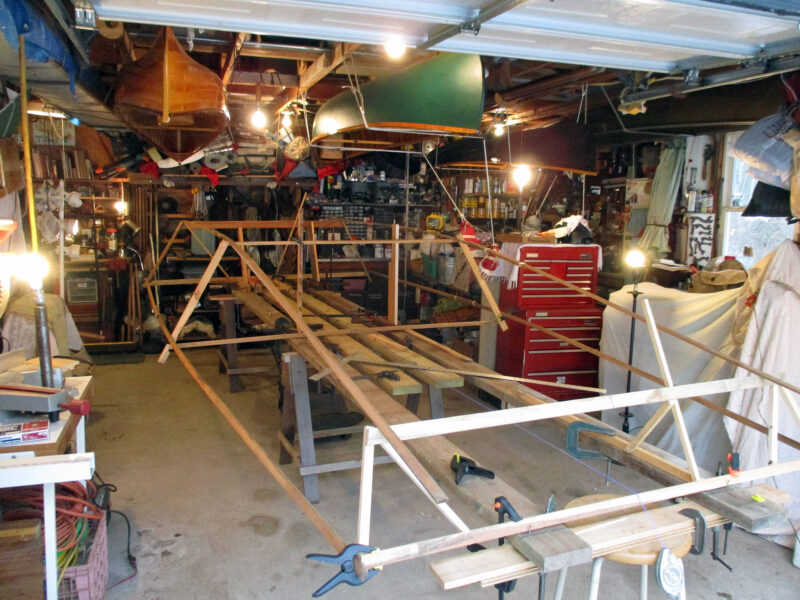
Jim: “That’s the first time I got to see what my so-called plan would look like in real life. Uncle John’s classic Louisiana Johnboat happened to be a boat that I like the looks of. I decided I wanted more flat bottom and less curve so I moved my center form toward the bow a little bit and drew that curve from the sideview full size. That’s what I went with. I’m pretty happy with it.”
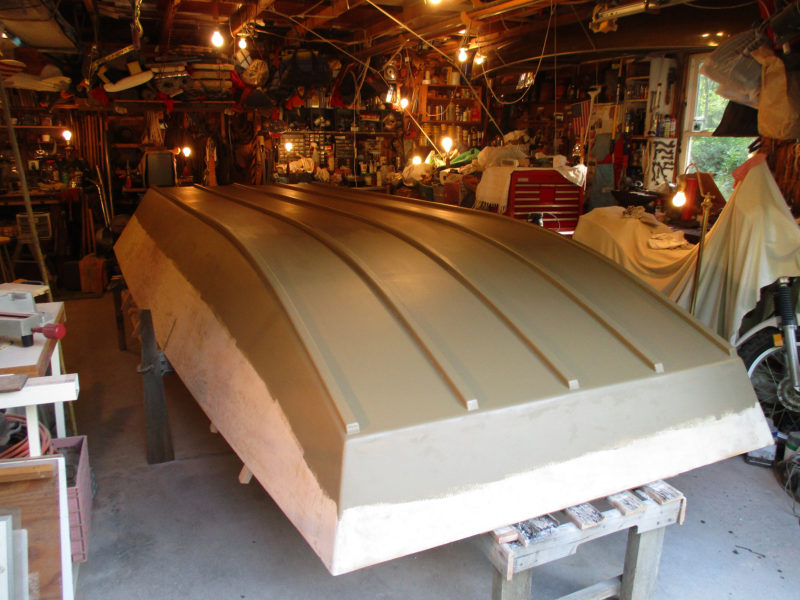
Jim: “I turned the hull over right in the garage, alone. I tend to collect whatever anybody doesn’t want and when I needed a come-along I was able to find four of them. With them I was able to lift the boat. I lowered one side of the boat and rested it on dollies and then cranked the other side up with the come-alongs until it was vertical. I got it all the way over and set it at working height, right-side up.”
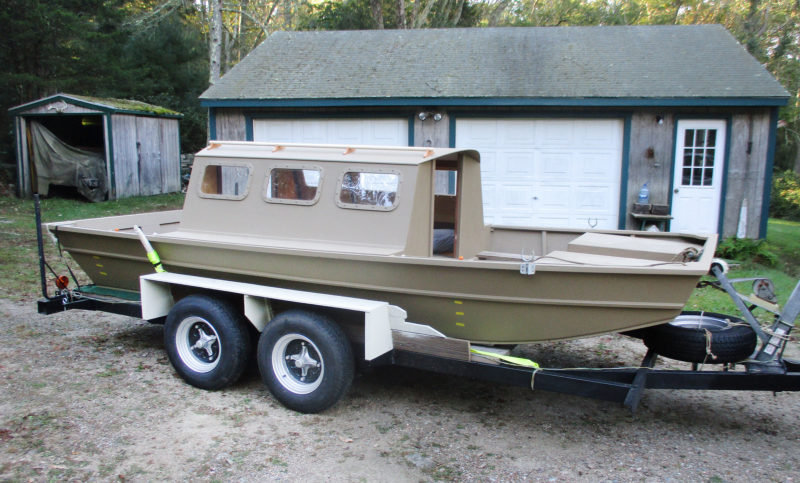
Jim: “That’s the mobile-home trailer. Of course, I had to buy that winch gizmo, the whole thing. That’s my garage in the background. When entering or leaving the garage shop, I would acknowledge the boat’s presence or compliment its progress. Since there were six canoes hanging from the rafters, I addressed it specifically as Boaty, pronounced Bodie because that was easier, I guess. On my design doodles it was ‘Johnboat Camper.’ JC Bodie looked too obvious, so it became JAYCEE BODIE.”
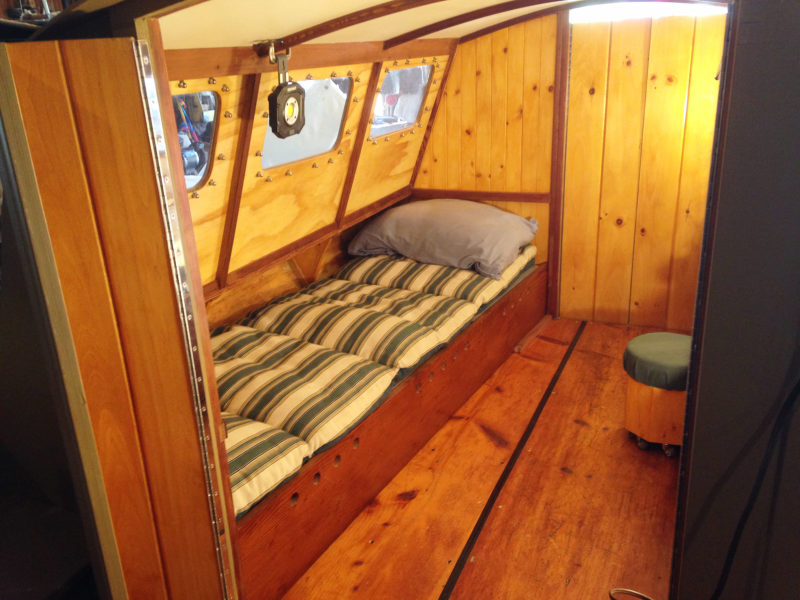
Jim: “That’s the port side, my bunk. Back when I quit teaching…I taught for two years after college in St. Louis County…I built a camper out of a panel truck. Well actually, my brother and a friend and I bought a St. Louis County water truck and filled it full of camping gear and went out to Wyoming and backpacked different places in the mountains and stuck our heads into Utah and kept going around Wyoming then I bought the truck from them. It was 8′ long and as wide as this boat. That’s where the design came from except the camper didn’t have a bunk and I slept on the floor. The johnboat’s head, stowed in a compartment under the mattress along with toilet paper and a bag of sawdust, is just a bucket with a plastic bag.”
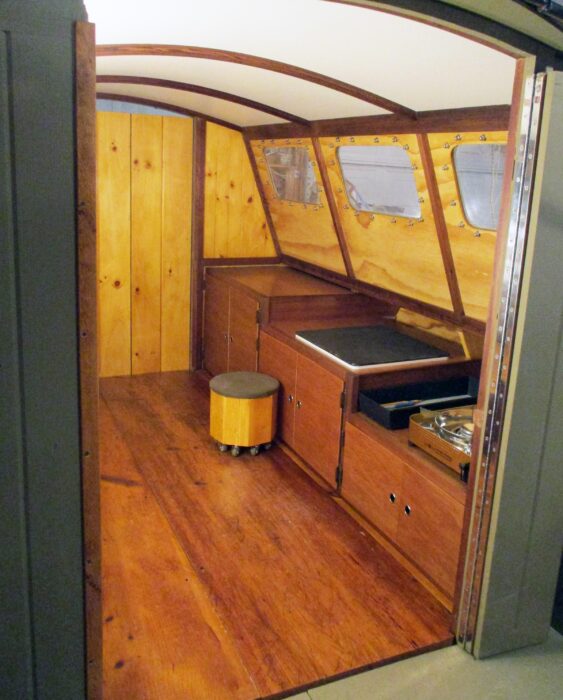
Jim: “The galley is on the starboard side. I had a rolling stool in the truck so I have one in the johnboat.”
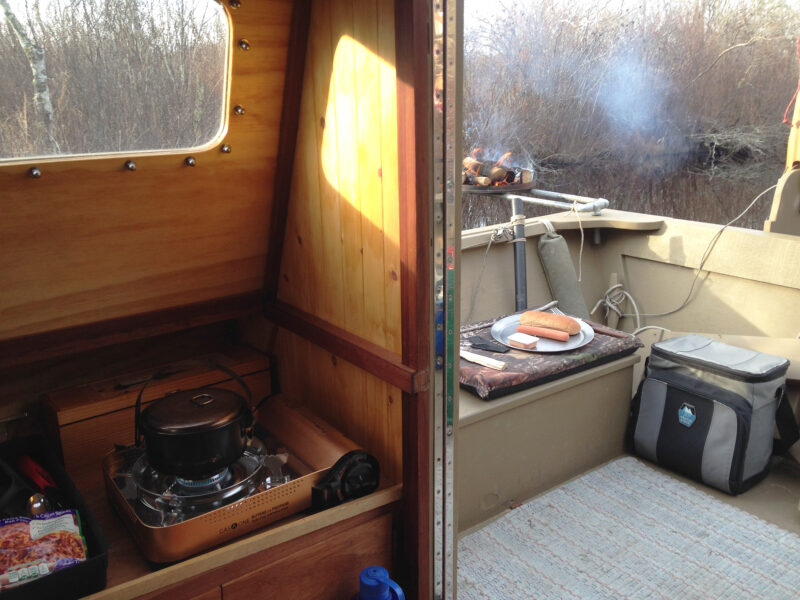
Jim: “I bought this stove just for this boat. I still have the ’60s model double-burner propane stove that was in my truck, the camper. It’s heavy; it’s got cast iron. The galley has room for a double stove, but I didn’t want the big tank, so I use this little stove with the 1-lb propane tanks and they’re underneath the cabinet. I’ve never used the teeny fuel canisters that look like a paint spray can. I can refill these one-pounders, so that’s what I’m doing. On the starboard transom knee I have a hole where I stick a flag or set my fire pan. That’s probably the nicest feature. It gets the most uses anyway.”
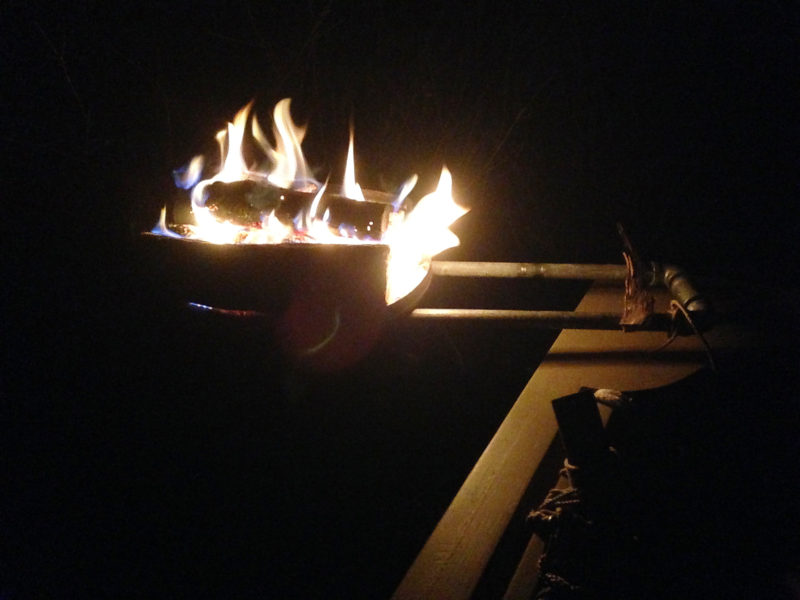
Jim: “The fire pan on the starboard quarter is a film case for old-time 35-mm movie film. My daughter was into photography and teaches photography in college. They were throwing a bunch away and of course I don’t let anything get thrown away. She said ‘just be careful with the film because it’s very flammable.’ I said, ‘Well, maybe I’ll take it on my camping trip!’ But anyway, the cans had been bouncing around and I had thought of using something bigger, but I’ve always had very small campfires. Generally, what I do at night is watch the fire until it gets late.”
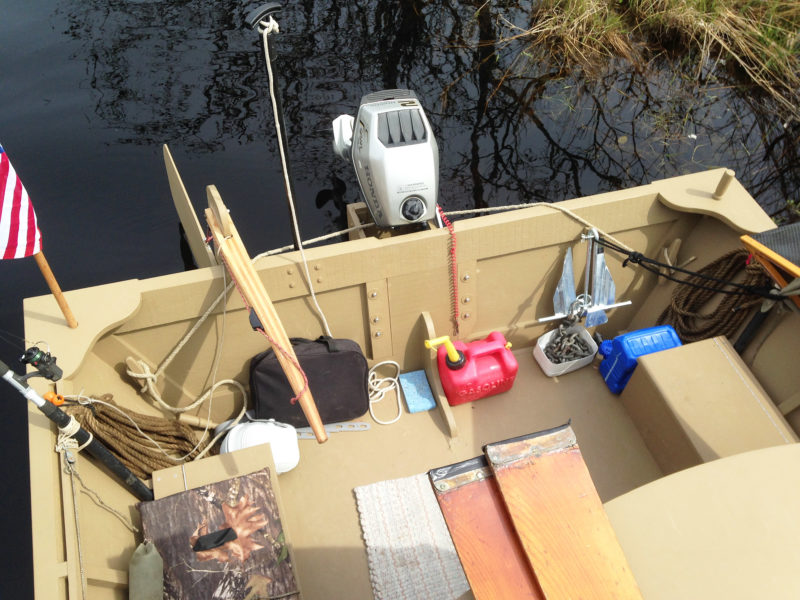
Jim: “The blue thing is my battery. I have a battery for recharging things like the phone. I have a rechargeable that’s the anchor light but I don’t have running lights yet—but I’m working toward that. In the black bag is my anchor line. I wanted it kept neat. I’ve had enough anchoring with my sailboats. I prefer not to anchor. It brings up all the mud. But I figured I could anchor off the stern as I go toward the beach, hit the beach, and just throw the anchor off the stern and then do whatever I have to do. The tape on the oars is trying to keep the copper from scratching up the paint. I’ve got some makeshift things scattered around. The white things next to the black bag are kneepads. I kneel in my canoes when I paddle and I use kneepads like the white ones here. I stumbled once and landed with my knee on a root and now it’s difficult to kneel. I’ve been using the kneepads on the boat as well whenever I kneel. I have several pair of them because I’m trying to protect my knee and I want to keep paddling. What am I? 78, going on 79 this month. We’ll see.”
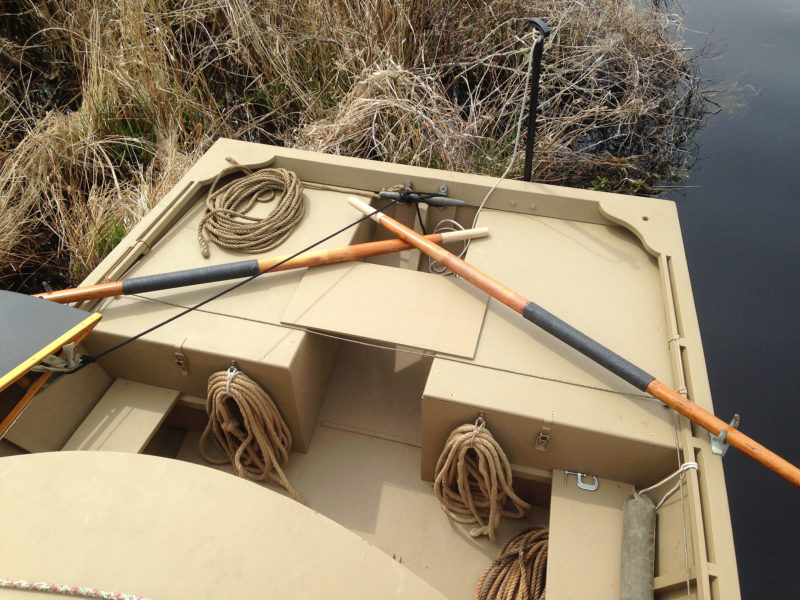
Jim: “Because I’ve had big boats and little boats I have some boat parts around and that’s where that great big bronze cleat comes from. I put it there because it’s been sitting around the garage for a long time. I know it’s overkill, but it was free and sitting around, wanting to be used. As well as my oar locks, I had two sets of these, too, so I had to use those. The oars I bought for a boat in the backyard, a Rangeley Lake boat from Maine. They’re a little short for the johnboat but they’re the longest I had. I’m using them until I can find something else. I wouldn’t use spoon blades on this boat.”
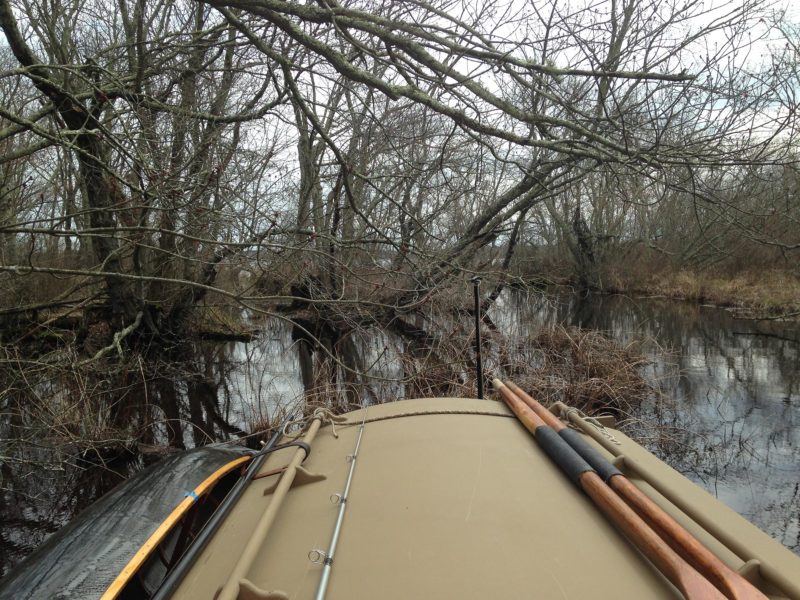
Jim: “This is a pond near the Pawcatuck River. I’m anchored with my pole here, practicing what I hope to do when I’m on some kind of voyage. It will be real handy where I expect to be, hope to be, or might not ever be. ”
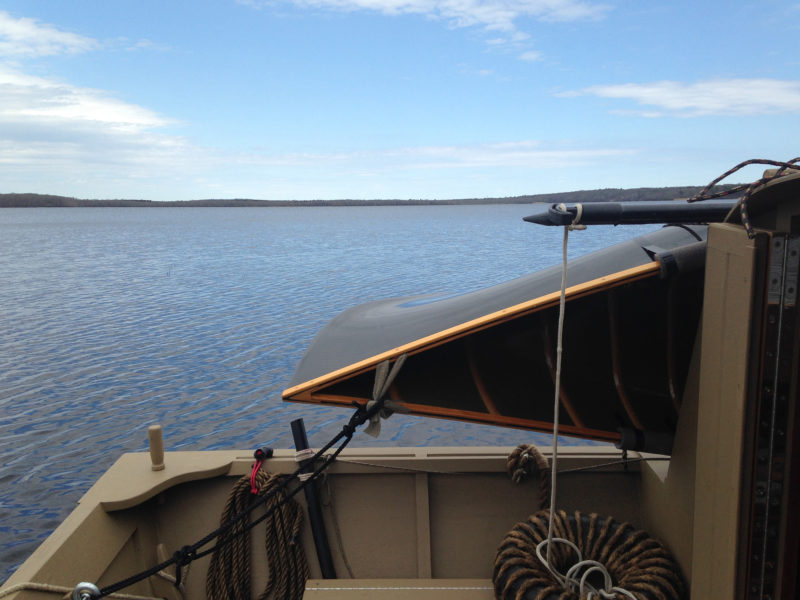
Jim: “That’s just one of the ponds in Rhode Island. The Wee Lassie canoe here is the fourth that I built. The first one I built was a canvas skin on open wood framing. I had bought some good cedar, boat cedar, to build a lapstrake one but after I built the skin one, I just went paddling and didn’t look back. I’m more of a paddler than a builder…in my mind, anyway.”
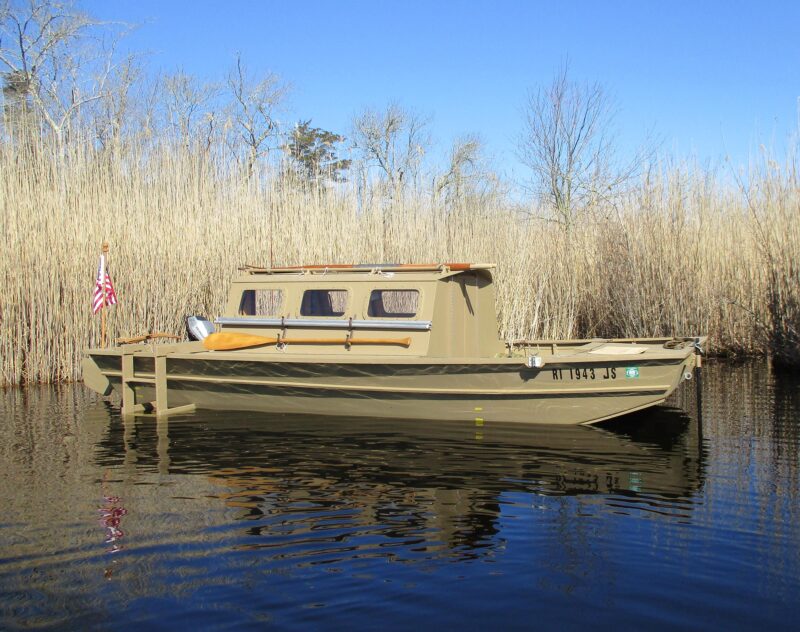
Jim: “I built the boarding ladder strictly because I thought I would have difficulty getting into the canoe from the boat, but I couldn’t use it. First of all, the second step is under water and I have had enough of wet feet. If want to go paddling from my johnboat, I don’t want wet feet. Standing on the top step was no good because that made me really unbalanced. That was no better than laying on the deck, so I did not use it. I didn’t even take it the next time I went out. If you’re the kind of person who likes to swim, the ladder would be fine but I’m an on-the-water not an in-the-water kind of guy.”
The johnboat is not really for here in Rhode Island. It’s for the big rivers of the Midwest. We’ll see what happens. I don’t think we can get out of here unless things change. But you never know. It doesn’t matter. I’ve enjoyed building it and it has been great fun. I did add some more things. I put the shelves beside the bunk so there’s a place to put a few things: clothes, a wallet, whatever. I’ve enclosed the space behind the cabinets and those spaces will be hidden and look like just a panel to hide the hull. I’ve got them attached by magnets, so I can squirrel something in there like money or papers or whatever. Whatever I want to hide, I’ve got a hiding place.
I built the boat for finishing the Ohio River and then seeing the tributaries and the interesting areas along the Ohio, and maybe the Tennessee River. And there’s the Cumberland. The Tennessee goes way on up to Knoxville. That would be a nice place to spend the winter. But we’ll see.![]()
Christopher Cunningham is the editor of Small Boats.
If you have an interesting story to tell about your adventures with a small boat, please email us a brief outline and a few photos.
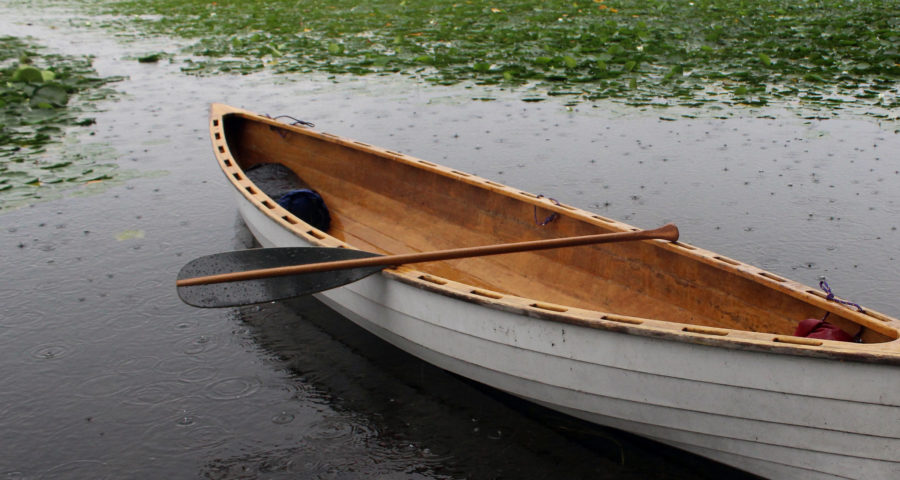
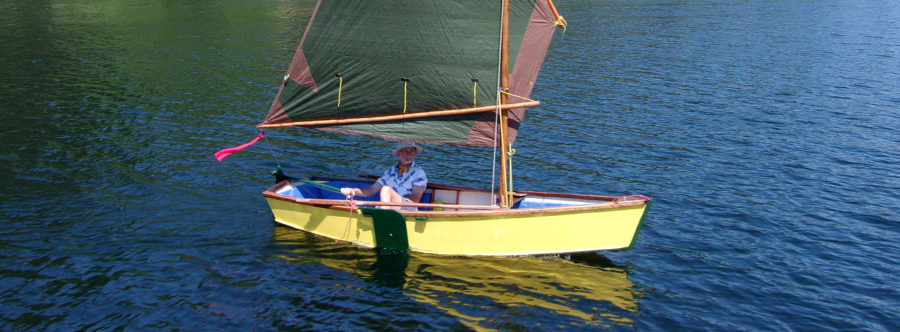
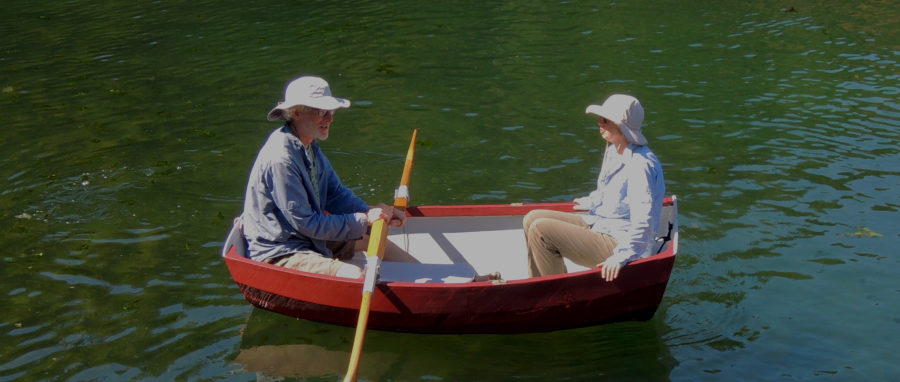
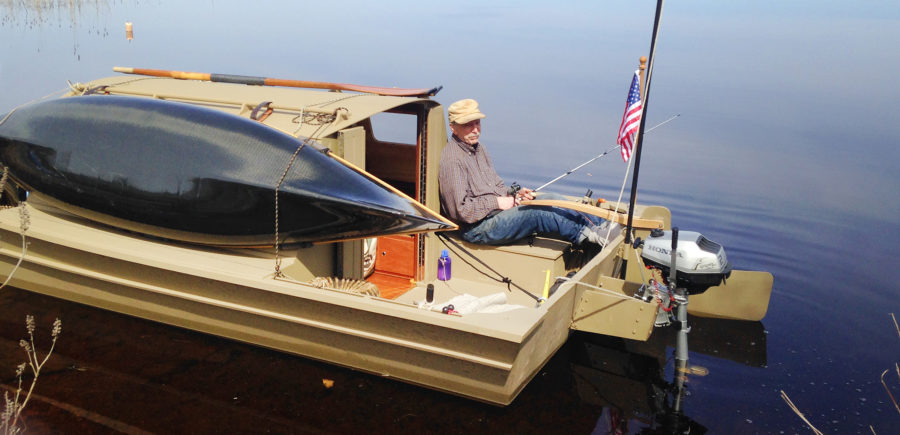
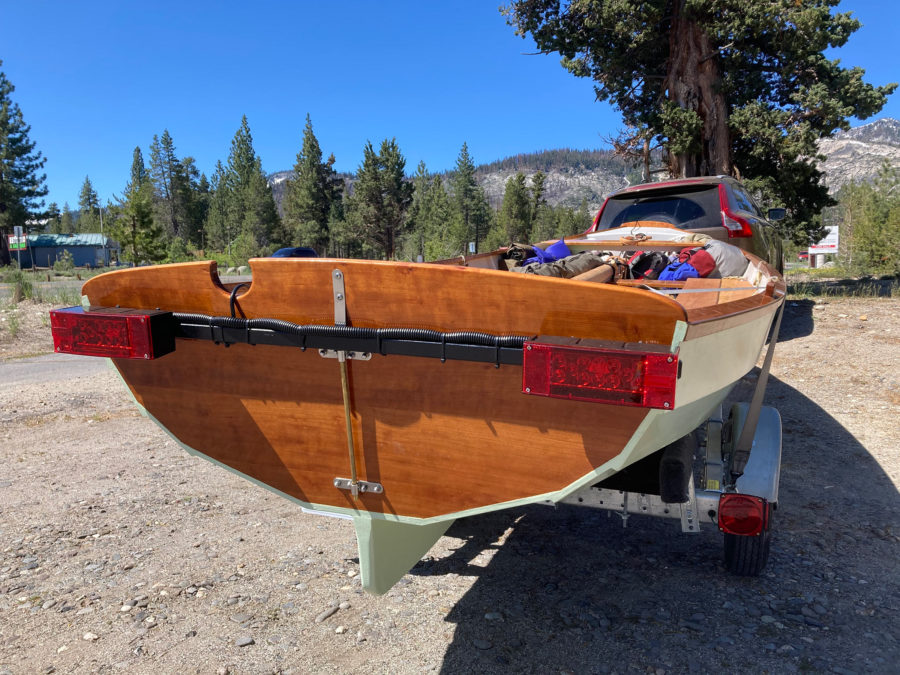
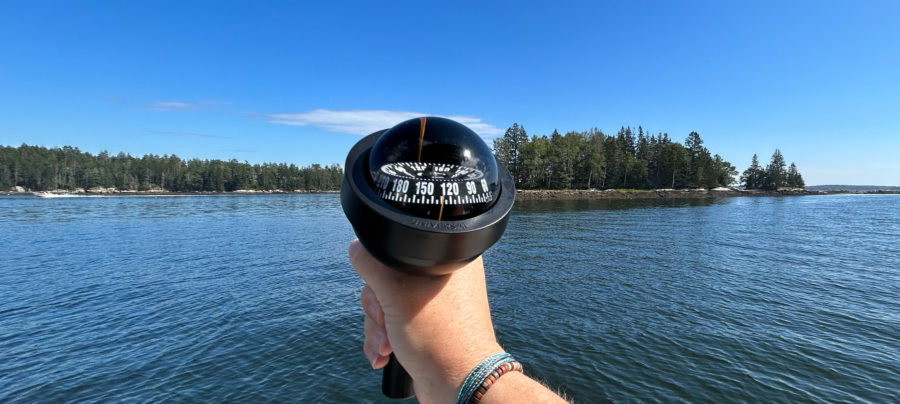
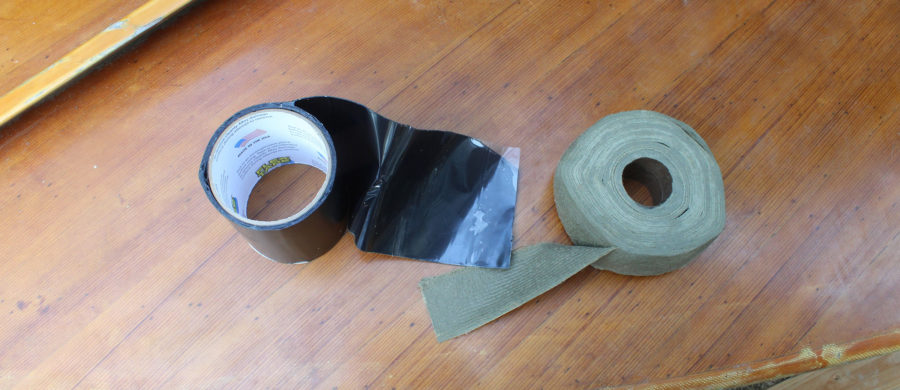
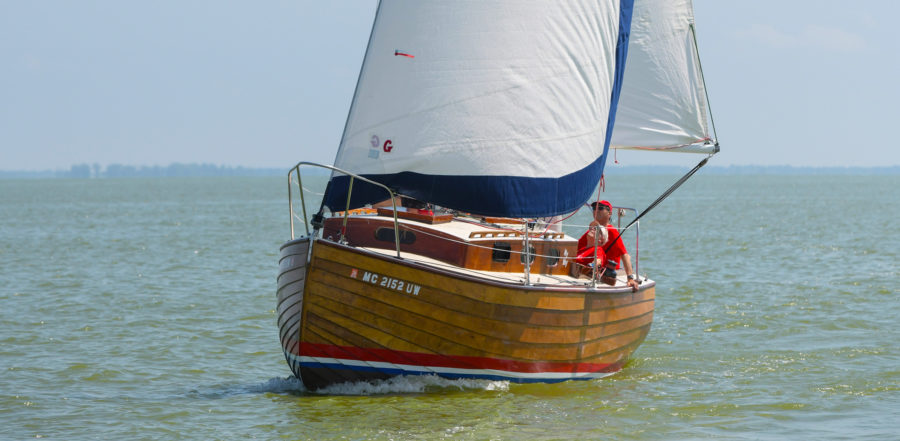
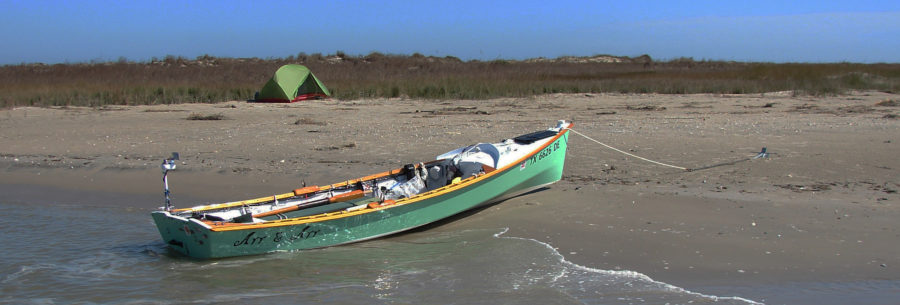
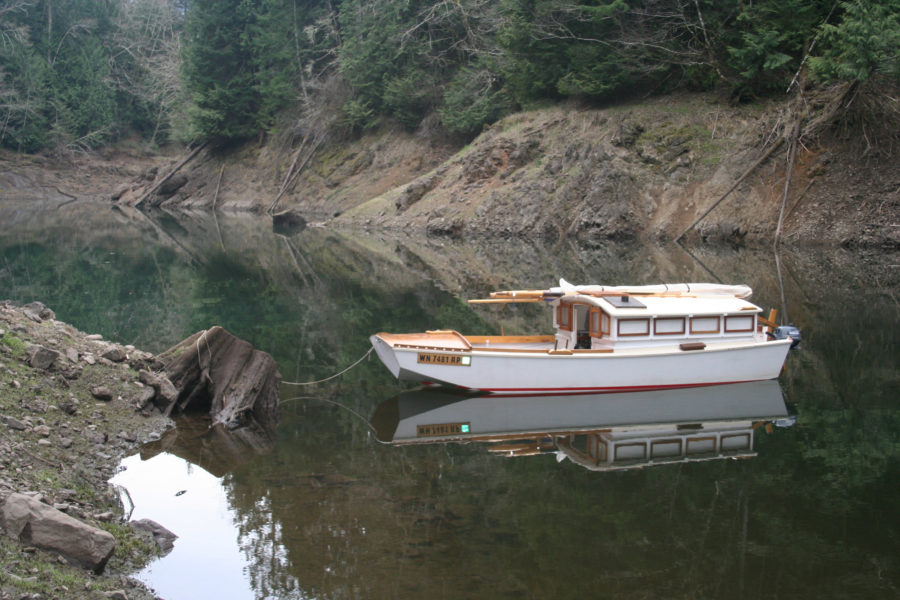
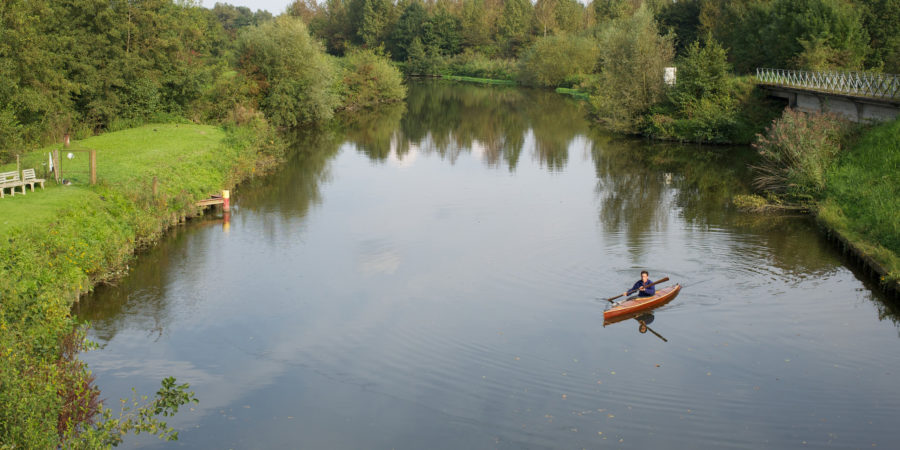
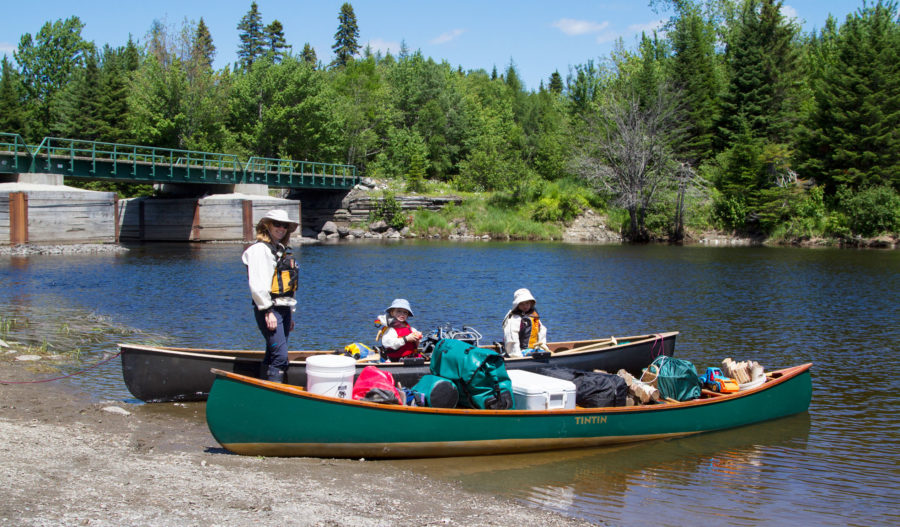
Thanks for sharing………what an incredible story.
Interesting man, interesting life. I love this boat. This is exactly the type I would like to have to go around my local rivers and streams, with the option to use to make it to the Land Between he Lakes. I would love to get some general measurements.
Hi Curt,
There are some different details on the classified ad listing.
https://smallboatsmonthly.com/acadp_listings/15-wooden-jon-boat-with-cabin/
What other information would you like to know?
Best,
Zoey
Check out the Jim Michalak design Campjon or Hapscut.
Thank you and Jim Schroer’s family for a wonderful story. It was waiting for me to read after a day spent painting the boat (we built) with my 22-year old grandson. Salt water and boats have been central to most of my 77 years.
Jim held the record for a time as the fastest time from St.Louis,MO. to Cape Girardeau, Missouri, on the Mississippi River via a single-handed canoe. And the year he sailed from California to Hawaii he was the smallest sail boat to do so.
Bill Schroer,
Jim’s brother
Thanks for a great story!
Wonderful story, this one will be read more than one time. I’ve long been fascinated by the idea of a large jonboat with a cabin, like Jim Michalak’s Campjon. 20′ might be more to my liking. Wonder if I could manage the Great Loop by watching my weather and sea-states when crossing the big waters? (Yes, I know it sounds crazy.)
So the camper jonboat sure is intriguing. Reminds me of Gartside’s recently published 16′ shanty. I find myself looking at larger craft so I can bring along friends and family, but realistically I most often find myself solo. And I am fine with that. And if I am overnighting it is even more likely that a craft such as this is perfect. Thank you for the article. I appreciate seeing others thinking along similar lines.
What an inspiring story! Thank you for sharing it with us.
Thank you (and Sher and Zoey) for this wonderful story. Much like Anke and Dave of “Mustelid”, it is the story of a chosen life; and a life well lived.
And the outboard fire pit may have to become a feature of my skiff build.
Thank you for that lovely comparison. 🙂
You have had a very interesting life. Love the john boat, an adventure in itself!
I’m only now stumbling across this article as I had somehow messed up my subscription. I’m really happy that Bill’s life and boats were finally written about. I met Bill in September of 2022 when I bought a Rangeley guide boat from him. I had driven down from New Hampshire, and he graciously showed me around his shop, which was filled with exquisite canoes, all well cared for. For me though, the highlight of the tour was the JAYCEE BODIE. Once Bill and I got talking about camping on the water, he realized that he had inquired a few years earlier about buying my 21′ Hudson Bay freighter canoe, which I had rigged with a sleeping cabin. We more or less had the same ideas about camping on the water, so I was thrilled to see what he had come up with using a jon boat hull. I won’t forget that sliding stool in the cabin, which made moving about a cabin with little headroom quite efficient. You could see results of years of experienced, trial-and-error tinkering all over that boat.
Sher and Zoey, my heartfelt condolences to you. I suspect that your lives were made all the more interesting and exciting with Bill steering from the stern. Thank you for sharing your story.
Tim Jennings
Enfield, NH